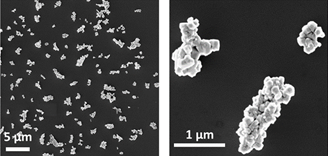We present a new type of biocompatible surface-functionalized magnetic microparticles for cancer cells destruction. The magnetite particles, covered with polyethylene glycol molecules, are shown to favor cell-death via apoptosis when set into vibrations by alternating magnetic field.
Ball-milled magnetite particles
A team from SPINTEC, in collaboration with researchers from SyMMES, has recently developed a new type of surface-functionalized magnetic microparticle for the destruction of cancer cells.
The use of magnetic particles for biomedical applications opens interesting perspectives. One of these is the destruction of cancer cells induced by the magnetic vibration of micro particles. However, despite excellent results obtained with in vitro cell cultures, in vivo studies have so far been disappointing. Two elements have been identified to explain this failure: the poor dispersion of the particles into tumoral tissue, and the reduction in the particles endocytosis which, contrary to in vitro, accumulate in the extracellular matrix.
The particles that we have developed are intended to overcome these shortcomings. They are anisotropic magnetite grains obtained by powder ball-milling. Ball-milling allows mass production of particles, of average size around one micron. This size is such that the vibration of the particles by application of an oscillating magnetic field generates forces up to 10 nN, which is in the desire range to induce physiological stress to the cells. The particles also exhibit good dispersion properties in solution, which is attributed to their closed-flux magnetic structure. After synthesis, particles are functionalized by surface grafting of polyethylene glycol (PEG) molecules of different lengths. The goal of PEGylation is to ensure better dispersion within the cells, which has already been observed in other studies, and to modify the particle-cell interactions, by modulating the transmitted mechanical force.
The new particles were tested by assessing their ability to induce cell death with glioblastoma cancer cells. We first observed that, as expected, PEGylated particles evenly disperse among cells and undergo endocytosis. After subjecting the particles-loaded cells to a rotating magnetic field, cells metabolic activity and membrane integrity measurement indicated that PEGylated particles do induce a decrease in cell viability – although at a lower pace than bare particles – and a higher ratio of apoptotic cells relative to the number of necrotic cells. Most interestingly, it was observed that a low magnetic field frequency (down to 2 Hz) significantly enhances the occurrence of apoptosis.
These results highlight a difference in the cell death mechanism according to the type of particles – bare versus PEGylated – and the conditions of the mechanical stimulation. We attribute this to the damping of the vibration from the PEG chains, which opens promising perspectives for the future development of cancer-treatment strategies.
Teams: Health and Biology, Instrumentation
Collaboration: Marie Carrière and Yanxia Hou-Broutin (SyMMES)
Funding: ERA-NET COFUND NANOVIBER, FET ABIOMATER, Projet UGA/IRGA Magcell
Further reading: Magneto-mechanical treatment of human glioblastoma cells with engineered iron oxide powder microparticles for triggering apoptosis, C. Thébault, M. Marmiesse, C. Naud, K. Pernet-Gallay, E. Billiet, H. Joisten, B. Dieny, M. Carrière, Y. Hou and R. Morel, Nanoscale Adv. 3, 6213 (2021).
Contact: Robert MOREL

